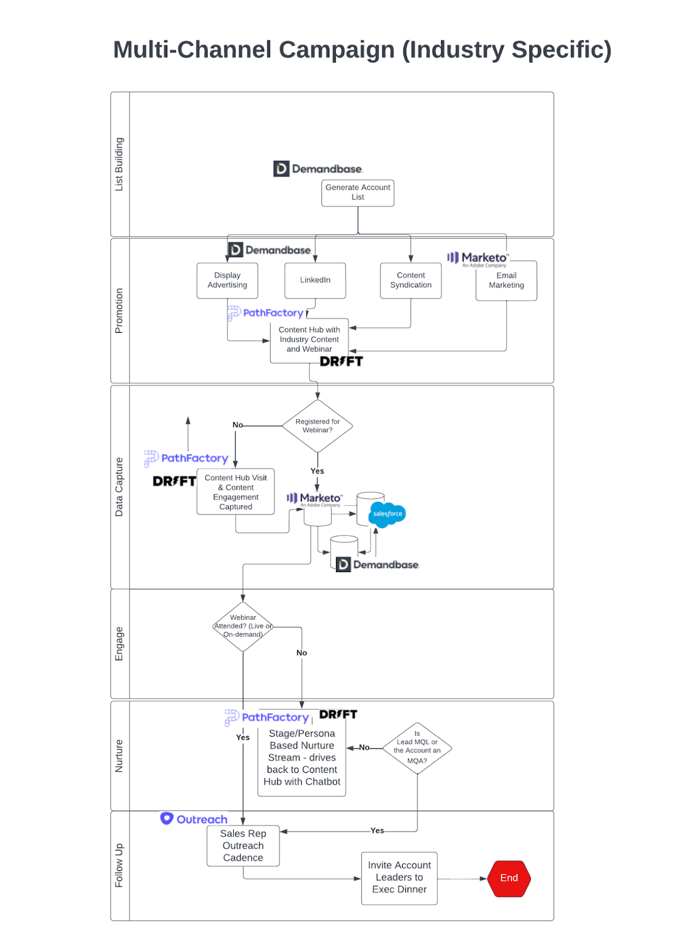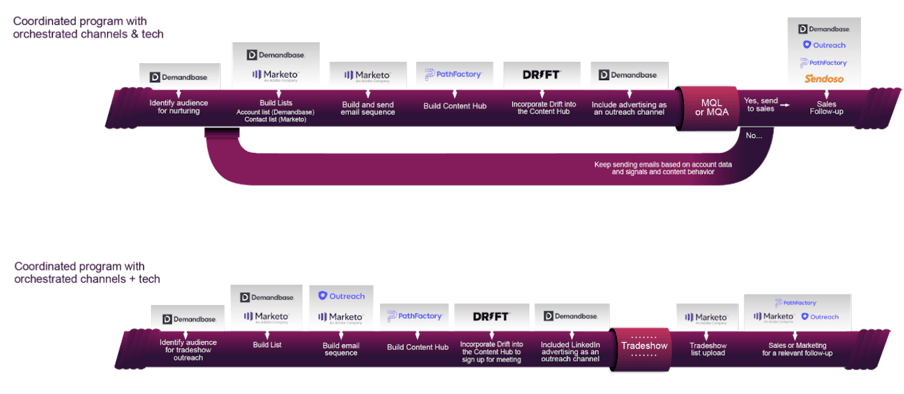
ARTICLE: 3 Real World Use Cases That Make the Most of Your Tech
A Real-World Use Case for Making the Most of Your Tech
If you’re like 70% of CMOs, martech has become a crucial component of your marketing strategy. With the advent of AI and other generative tools, marketing technology will only continue to accelerate.
Yet most martech stacks remain somewhat primitive when it comes to multi-channel application and cross-functional adoption. Simply having an ABM platform, chat, content hub, direct mail, sales execution hub, etc., does not equate to having a martech strategy.
Let’s take your webinar tech flow, for example. Chances are, your martech application for a webinar looks something like this:

In other words, only one tool (Marketo) is applied to each step across the program. It gets the job done, sure. But what about the other tools in your tech stack that could be applied to improve the process?
On the other hand, a fully integrated webinar flow that applies the full power of your tech stack looks something like this:

How do you get from “before” to “after” with your tech stack? By applying the power of use cases. In this article, we’ll walk you through how we went from “before” to “after” with a real company by breaking down the process of designing and applying a use case to their tech stack for a multi-channel campaign.
The Scenario: Lots of Martech, Only using a Fraction of the Power
When it comes to fully leveraging your martech stack, it’s not that the people on your team don’t want to leverage technology in a more modern and engaging way. More often than not, it’s a question of enablement — they simply don’t know how. Plus, your tech stack might need some work before it’s possible to define cross-functional use cases.
This was exactly the case at a real company we worked with that we’ll call ABC Company for the purposes of this article (and to keep our client anonymous).
ABC Company’s Dilemma
When Inverta began working with ABC Company over three years ago, our first impression was how rich their tech stack was. They truly had everything — Marketo, Salesforce, Demandbase, Drift, Outreach, PathFactory, and Sendoso. They must have had a stellar strategy to employ those tools, right? Not exactly.
As we continued to work together, we uncovered just how much that rich tech stack wasn’t being applied. Various problems started cropping up:
- Their technology was siloed between different teams.
- Most of the technology wasn’t integrated with each other.
- The data collected in the various systems was not being leveraged to inform campaigns and programs, nor was it being passed to Sales to improve their processes.
In short, the stack was all sizzle and no steak. For example:
- Their ABM Campaign Manager was the only one using Demandbase and Sendoso.
- Their web team “owned” Drift, and were the only ones using it.
- The person who purchased PathFactory left the company, so the web team started using just one (!) feature of the technology, but without a broader strategy for it.
ABC Company needed a fully enabled martech ecosystem that would enable them to customize their services and apply their technology to campaigns across channels and functions.
Inverta’s Approach
To start pulling the true value out of their tech stack, we had to do a few crucial things up front:
- First, redefine ownership to eliminate the silos.
- Then, audit the integrations and data flow between the technologies (and work with their MOPS team to implement what was missing).
- Lastly, develop use cases for each technology to start to show the art of the possible.
From there, we worked within their campaign planning process to create use cases that would scope in the various technologies, allowing them to take advantage of all their tech stack had to offer.
The Goal: Execute a Martech-Enabled, Multi-Channel Campaign
With the groundwork successfully laid for their martech stack, ABC Company was ready to apply the full potential of their technology to an omnichannel marketing campaign. Their goal was to launch a multi-channel campaign to identify, target, and engage contacts and support the sales cycle through the closed/won stage.
Below is an overview of their business goal, marketing objective and campaign approach for the campaign.
Business Goal
Expand into the financial services segment with a revenue target of $5M.
Marketing Objective
Prioritize accounts in the financial services sector and focus marketing efforts on those accounts to drive $20M in pipeline, resulting in $5M revenue.
The Campaign
ABC Company kicked off with an advertising motion to drive all leads to a microsite where they could consume content to learn more about the problem and solution. In this case, the content was Finserv specific and ranged from thought leadership to decision stage assets. Leads were also presented with an option to register for a webinar to learn more from existing customers.
Then, leads who attended the webinar (either live or on-demand) were pushed into a sales cadence, as well as accounts with a score that indicated they might be ready for a sales conversation. Sales invited executives within the account to attend an executive dinner.
Lastly, marketing efforts didn’t end but were driven by the account score which could indicate a need for advertising to engage more contacts in the buying group to learn more. A closed won status was the culmination of the campaign.
With their technology primed and their campaign tactics and target defined, ABC Company was ready to build a use case for their technology that specifically applied to the multi-channel marketing campaign.
The Use Case: Defining Programs & Tactics
To help ABC Company get the most out of their martech stack in the mutli-channel campaign, Inverta outlined the following programs and tactics to lay a foundation for the complete use case.
Target List
Review account scores and intent data to generate the FinServ target account list
Promotion
- Account and intent-based display advertising
- Account-based LinkedIn advertising
- Drift bot on website to direct FinServ accounts to a microsite with FinServ focused content
- Content syndication to gather new contacts at the FinServ accounts
Data Capture
- All advertising contacts and website visitors are directed to the microsite. A webinar is one of the promoted assets to gather contact information. A form strategy is also deployed to prompt the visitor for contact info.
- The microsite captures content engagement and the account and/or contact level.
- The data captured goes into the marketing automation platform and is synced with the ABM platform and CRM.
Engagement + Nurture
- Emails are sent to all contacts promoting content and directing them back to the microsite.
- Webinars (live and on-demand) are promoted for the contacts to learn more.
- When the account and person scores indicate strong engagement, other high value offers will be offered along with promotion to the sales channel.
Sales Outreach + Marketing Support
- Sales will start a cadence of email, phone, and LinkedIn outreach directing contacts back to an updated microsite where the sales representative’s information is included.
- Depending on the CRM and ABM indicators, marketing may also be continuing their outreach via display advertising, paid social, or direct mail to help accelerate the sales cycle. Note: with the increase in “anonymous” buyers, keeping a steady stream of promotion to drive website engagement is critical.
Technology Leveraged
- Marketo, Drift, SFDC, Demandbase, Outreach, PathFactory
Data Collected
- Channel Engagement (e.g., microsite, website, email, webinar, direct mail)
- Campaign Engagement
- Account Engagement
- Account Reach
Reporting
- MQLs and MQAs
- Campaign Performance
- Increase in Account Engagement
- Pipeline Value
- Bookings
Once the campaign flow was mapped out, we then audited all of the technology integrations and the data flows. This step ensured they were able to trigger the intended actions and that all the necessary data was flowing between their systems to inform the campaign actions.
Here’s a map of what the technology use case looked like according to each stage of the campaign:
Finally, the last step of applying the use case for their multi-channel campaign was enablement and education for the team who would execute on the use case. The goal was to help them understand the new way of executing these multi-channel campaigns, as well as all of the features that were now available to modernize their approach.
Results
Not surprisingly, the multi-channel campaign performed better than other single-threaded programs: 14.5% increase in MQLs, 63% percent of the target audience engaged and pipeline and bookings exceeded expectations.
A number of factors played into getting far better than our average results. The use case approach provided the motivation to pursue a coordinated outreach across the multiple marketing teams to a target audience that showed signs of interest. Support was provided to ensure each team understood their role and responsibility in the larger campaign.
Initial success has led to additional use cases to further reinforce the integrated use of their tech stack, represented by the following diagrams:

As we stated in our last article, it’s not the size of your martech stack, it’s your range of use cases. Leaders in this space have implemented dozens of use cases and better martech capabilities are strongly correlated with better market performance.
The key to success is having a methodology for enabling a range of use cases. Anyone can buy martech products, but to unlock the real value of martech, you must invest significantly in enablement: training on how to use the tools, education on how to produce great marketing with those tools, clearing the runway of organizational hurdles that would prevent or slow down such use cases, and encouragement and incentives to lean into experimenting with these new capabilities.
At Inverta, we know how powerful use cases can be when applied to your martech. Follow along with our martech experts in our Masterclass series here, or learn more about what we do by contacting us today.
